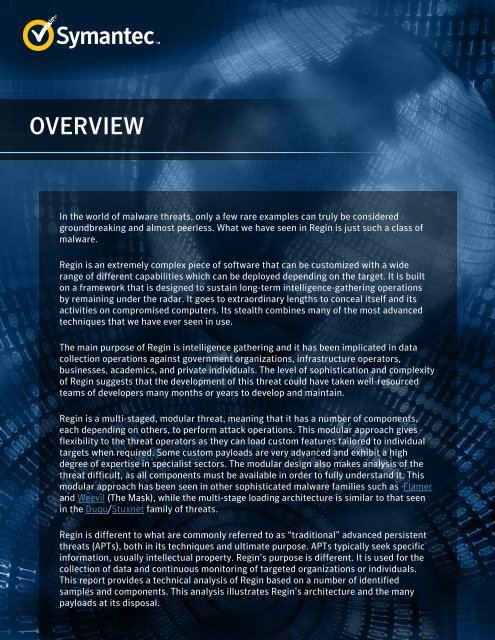You also want an ePaper? Increase the reach of your titles
YUMPU automatically turns print PDFs into web optimized ePapers that Google loves.
OVERVIEW<br />
In the world of malware threats, only a few rare examples can truly be considered<br />
groundbreaking and almost peerless. What we have seen in Regin is just such a class of<br />
malware.<br />
Regin is an extremely complex piece of software that can be customized with a wide<br />
range of different capabilities which can be deployed depending on the target. It is built<br />
on a framework that is designed to sustain long-term intelligence-gathering operations<br />
by remaining under the radar. It goes to extraordinary lengths to conceal itself and its<br />
activities on compromised computers. Its stealth combines many of the most advanced<br />
techniques that we have ever seen in use.<br />
The main purpose of Regin is intelligence gathering and it has been implicated in data<br />
collection operations against government organizations, infrastructure operators,<br />
businesses, academics, and private individuals. The level of sophistication and complexity<br />
of Regin suggests that the development of this threat could have taken well-resourced<br />
teams of developers many months or years to develop and maintain.<br />
Regin is a multi-staged, modular threat, meaning that it has a number of components,<br />
each depending on others, to perform attack operations. This modular approach gives<br />
flexibility to the threat operators as they can load custom features tailored to individual<br />
targets when required. Some custom payloads are very advanced and exhibit a high<br />
degree of expertise in specialist sectors. The modular design also makes <strong>analysis</strong> of the<br />
threat difficult, as all components must be available in order to fully understand it. This<br />
modular approach has been seen in other sophisticated malware families such as Flamer<br />
and Weevil (The Mask), while the multi-stage loading architecture is similar to that seen<br />
in the Duqu/Stuxnet family of threats.<br />
Regin is different to what are commonly referred to as “traditional” advanced persistent<br />
threats (APTs), both in its techniques and ultimate purpose. APTs typically seek specific<br />
information, usually intellectual property. Regin’s purpose is different. It is used for the<br />
collection of data and continuous monitoring of targeted organizations or individuals.<br />
This report provides a technical <strong>analysis</strong> of Regin based on a number of identified<br />
samples and components. This <strong>analysis</strong> illustrates Regin’s architecture and the many<br />
payloads at its disposal.


